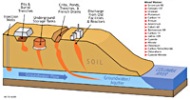
'Landmark' Deal Puts Hanford Cleanup on Track
The settlement of Washington State's 2008 lawsuit against the Department of Energy recommits the federal government to a cleanup of groundwater and waste stored in tanks at the Hanford Site, officials said this week.
The long cleanup of wastes stored at the Department of Energy's Hanford Site in southeastern Washington State may be realized, now that the parties have agreed to settle the state's 2008 lawsuit (later joined by the state of Oregon) against DOE because milestones in an earlier agreement were not being met. "Today is a historic day for Washington state, the Pacific Northwest and the Columbia River, a lifeline for our region," Washington Gov. Chris Gregoire said. "United States Energy Department Secretary Steven Chu and I, along with United States Senators Patty Murray and Maria Cantwell and state Attorney General Rob McKenna, announced an agreement that recommits the federal government to cleaning up America's toxic legacy at the Hanford Nuclear Reservation. Our agreement settles our lawsuit against the federal government and obligates it to a new, enforceable, and achievable schedule for tank waste cleanup at Hanford. And there is more: In tandem with the settlement agreement, Washington Ecology Director Jay Manning joined the United States Department of Energy and the Environmental Protection Agency in signing another agreement that establishes new enforceable deadlines to accelerate the cleanup of contaminated underground water plumes at Hanford. This means we're committed to intercepting these plumes before they reach the river, which serves 42 cities and towns and one million people downstream in two states."
Chu, Gregoire, and the others stood near the Waste Treatment Plant being built at Hanford on Aug. 11 to announce the proposed settlement. It sets a realistic schedule for startup of the plant and retrieving 53 million gallons of radioactive and chemical waste in 177 large, underground, single-shell storage tanks at Hanford.
DOE says the waste from the single-shell tanks will be removed and pumped to newer double-shell tanks and ultimately transferred to the plant, where it will be immobilized into a sturdy glass waste form through vitrification. Removing the waste from the single-shell tanks will take until 2040, and treatment of the wastes will be finished by 2047. "These new schedules are, in reality, aggressive, but achievable," according to DOE. "With a goal of accelerating the completion dates, the proposed agreement adds a process for reviewing the final completion dates every six years. Each six-year review will determine whether the completion dates can be accelerated. At three-year intervals, a detailed system plan will be generated to evaluate options for accelerating cleanup. This 'End Date Review Process' ensures that the Hanford tank waste cleanup remains as aggressive as possible."
The Washington State Department of Ecology's page about the agreement offers details about the settlement, contamination sources at Hanford, links, and activities to date.